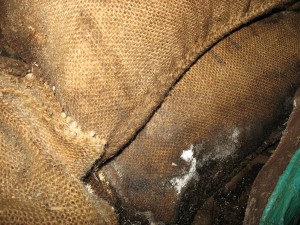I ran across these pictures and it helped me remember last spring!
Won’t be long now!
This is the time of year I am glad we have dried wild mushrooms in the pantry!
One of the Oyster Mushroom projects had a successful flush after sleeping through the winter.
The project started with burlap sacks filled with coffee grounds and oyster mushroom spawn. The sacks were stacked , bunker style outside, and left through the winter.
There was encouraging signs of life this spring and the bunker started getting water regularly. The gunny sack material sprouted mycelium throughout.
 The first flush was large, and the mushrooms were tender and had a light licorice smell. The clusters pulled from the fabric easily, and were pretty clean.
The first flush was large, and the mushrooms were tender and had a light licorice smell. The clusters pulled from the fabric easily, and were pretty clean.
I think the burlap material helped keep the moisture correct. This has been a problem when growing oysters in buckets. The material seems to wick the moisture where needed, much like mycelium. No wonder fungus loves burlap! Give it a try,
Dean
Rain…
Remember, it cannot happen without Rain!
More please!
The middle of summer is a tough time to look for edible mushrooms. Be patient my fellow mushroom fans…fall is coming!
This is a good time look for strange mushrooms. On a recent journey we found some from the Amanita family. Has anyone found any mushrooms of the weird lately?